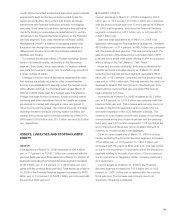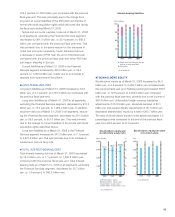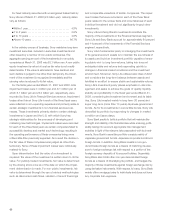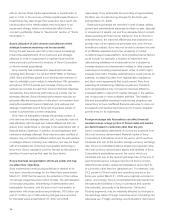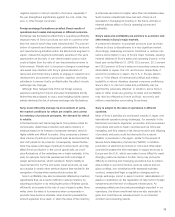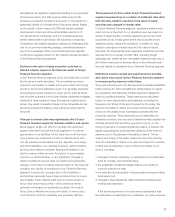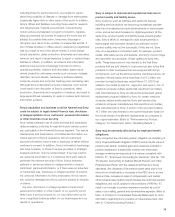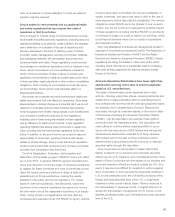Sony 2008 Annual Report Download - page 73
Download and view the complete annual report
Please find page 73 of the 2008 Sony annual report below. You can navigate through the pages in the report by either clicking on the pages listed below, or by using the keyword search tool below to find specific information within the annual report.
71
LIQUIDITY MANAGEMENT AND MARKET ACCESS
Sony defines its liquidity sources as the amount of cash balance
(excluding restrictions on capital transfers due mainly to country
regulations) and the unused amount of committed lines of credit.
Sony’s basic liquidity management policy is to secure sufficient
liquidity throughout the relevant fiscal year, covering such factors
as 50 percent of monthly consolidated sales and repayments on
debt which comes due within six months.
Sony has a total, translated into yen, of 597.2 billion yen in
committed lines of credit, of which the unused amount was
597.1 billion yen as of March 31, 2008. Major committed lines of
credit include a total, translated into yen, of 428.8 billion yen of
Global Commitment Facilities contracted with a syndicate of
global banks effective until March 2009, and a 150 billion yen
committed line of credit contracted with Japanese financial
institutions, effective until July 2009 where Sony Corporation
and SGTS are defined as the borrowers.
Sony’s working capital needs grow significantly in the third
quarter (from October to December) as a result of the general
seasonality of Sony’s business. In order to meet such short-term
capital requirements, SGTS maintains commercial paper (“CP”)
programs for the U.S., Europe and Japan CP markets. As of
March 31, 2008, the total amount to be issued under these CP
programs, translated into yen, was 1,201.3 billion yen. During
the fiscal year ended March 31, 2008, the largest month-end
outstanding balance of CP was 200.0 billion yen in September
2007. There was no outstanding balance of CP as of March 31,
2008. Sony controls the outstanding CP amount, as part of its
debt risk management, so that it does not exceed the unused
amount of committed lines of credit. In addition, SGTS maintains
a euro medium-term note (“MTN”) program with a program limit
amount that translates into 501.0 billion yen. There was no
outstanding balance as of March 31, 2008.
In the event of a downgrade in Sony’s credit ratings, even
though the cost of borrowing could increase, there are no
financial covenants in any of Sony’s material financial agree-
ments that would cause an acceleration of the obligation.
Furthermore, there are no restrictions on the uses of most
proceeds except that some borrowings may not be used to
acquire securities listed on a U.S. exchange or traded over-
the-counter in the U.S., and the use of such borrowings must
comply with the rules and regulations issued by authorities
such as the Board of Governors of the Federal Reserve Board.
Refer to Note 11 of Notes to Consolidated Financial
Statements for more information on short-term borrowings
and long-term debt.
RATINGS
Sony considers one of management’s top priorities to be the
maintenance of stable and appropriate credit ratings in order to
ensure financial flexibility for liquidity and capital management
and continued adequate access to sufficient funding resources
in the financial and capital markets.
In order to facilitate access to global capital markets, Sony
obtains credit ratings from two rating agencies, Moody’s and
S&P. In addition, Sony maintains a rating from Rating and
Investment Information, Inc. (“R&I”), a rating agency in Japan,
for access to the Japanese capital market.
Sony’s current debt ratings from each agency as of June 2, 2008
are noted below:
Moody’s
S&P
R&I
Long-term debt A2 (Outlook: A– (Outlook: AA– (Outlook:
Positive) Stable) Stable)
Short-term debt P-1 A-2 a-1+
CASH MANAGEMENT
Sony is centralizing and working to make more efficient its
global cash management activities through SGTS. The excess
or shortage of cash at most of Sony’s subsidiaries is invested
or funded by SGTS on a net basis, although Sony recognizes
that fund transfers are limited in certain countries and geo-
graphical areas due to restrictions on capital transactions. In
order to pursue more efficient cash management and in the
event of surplus capital generation among Sony’s subsidiaries,
uneven cash distribution is managed directly or indirectly
through SGTS so that Sony can reduce unnecessary cash
and cash equivalents and borrowings.
FINANCIAL SERVICES SEGMENT
In the Financial Services segment, the management of SFH,
Sony Life, Sony Assurance and Sony Bank recognize the
importance of securing sufficient liquidity to cover the payment
of obligations that they incur in the ordinary course of busi-
ness, and these companies abide by the regulations imposed
by regulatory authorities and establish and operate under com-
pany guidelines that comply with these regulations. Their pur-
pose in doing so is to maintain sufficient cash and cash
equivalents and secure sufficient means to pay their obliga-
tions. For instance, cash inflows for Sony Life and Sony
Assurance come mainly from policyholders’ insurance premi-
ums and Sony Life and Sony Assurance keep sufficient liquidity
in the form of investments primarily in various securities. Sony


